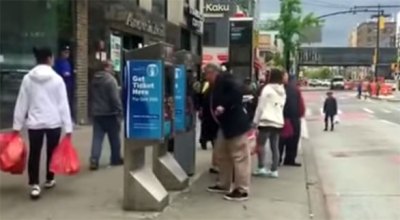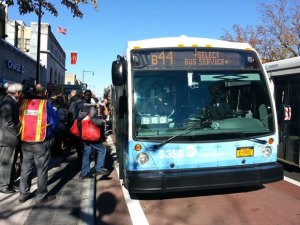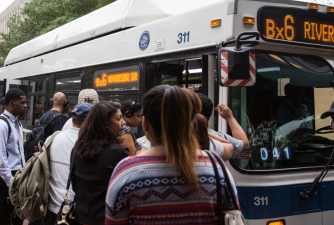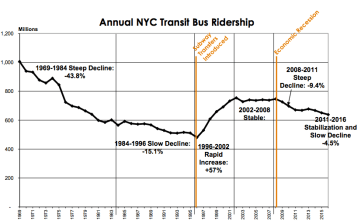Why Is the MTA OK With High-Speed Car Tolls But Not High-Speed Bus Fares?

MTA officials revealed today that the MetroCard will linger until 2022, though the agency still intends to phase in a new fare payment system starting in 2018. What remains unknown is whether the new system will enable electronic proof of payment, a fare collection method that promises to speed up NYC’s snail-paced buses.
The matter came up briefly during an MTA board meeting, after New York City Transit Vice President for Procurement and Material Steve Plochochi requested approval for an extension of the agency’s contract with Cubic, the company that built the MetroCard system.
Plochochi affirmed that a new fare payment system is still on track to begin deployment in 2018, but said the agency does not want to take a “cold turkey” approach and replace the MetroCard in one fell swoop.
Other than that, Plochochi didn’t divulge anything about the agency’s thinking with regards to the MetroCard replacement. “I really can’t go into details of the proposals,” he said.
Transit advocates have pressed the MTA to commit to a fare system that will facilitate electronic proof of payment on buses. By allowing riders to quickly tap a farecard or mobile device at any door, the technology could significantly shorten the boarding process and speed up buses systemwide.
Advocates urged the MTA to require electronic proof of payment capability from bidders responding to its RFP for the next-gen fare system [PDF]. Without the technology, bus riders would be doomed “to a whole new generation of boarding slowly, one-by-one, at the front of the bus,” said the Riders Alliance.
The MTA refused, citing concerns about “the very real threat of fare evasion,” even though fare evasion has not proven to be a problem with proof of payment systems in San Francisco or on Select Bus Service routes in New York. The agency hasn’t budged since then. New York City Transit Executive Vice President Craig Cipriano refused to commit to all-door boarding at this month’s City Council hearing on bus service.
Interestingly, the MTA dragged its feet for years on an analogous technological advance for motorists — cashless tolls. Advocates pressed the MTA to adopt cashless tolling for more than a decade, the agency’s pilot programs stagnated for ages, and other tolling authorities eventually left the MTA in their dust. Only when Governor Cuomo intervened this year did the agency finally commit to fully cashless tolls at all its bridges and tunnels.
At one point during today’s meetings, NYC DOT Commissioner Polly Trottenberg wondered aloud why board members were being rushed to approve cashless tolls without a discussion of potential pitfalls — including “fare evasion.”
For MTA officials, the answer is easy: Cashless tolls are on the fast track now because the motorists who stew in toll plaza traffic are a priority for the Cuomo administration. It’s a shame bus riders don’t get the same treatment.




